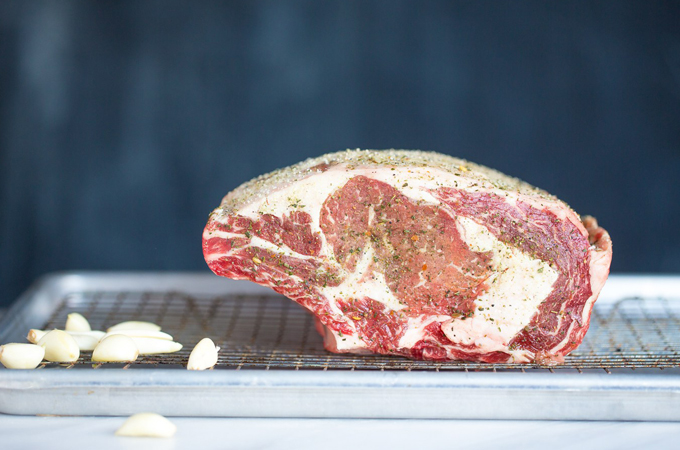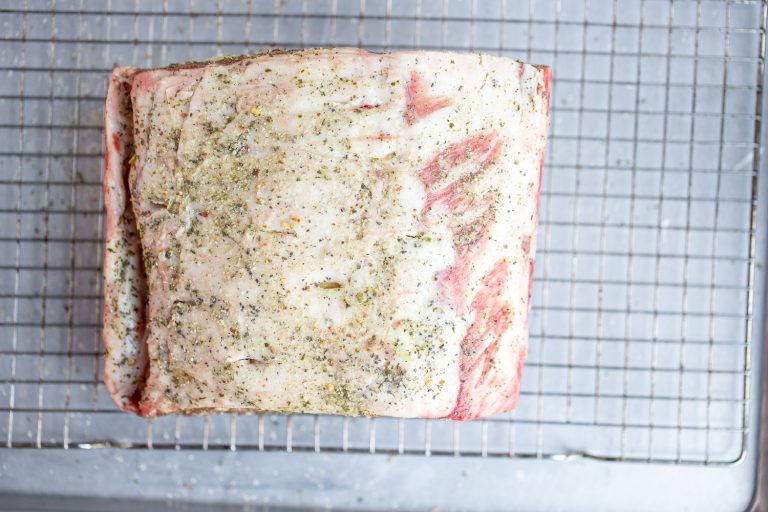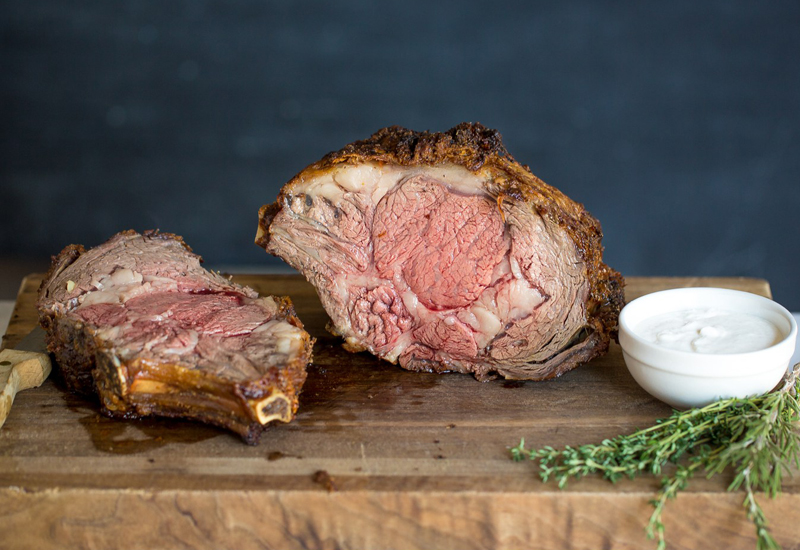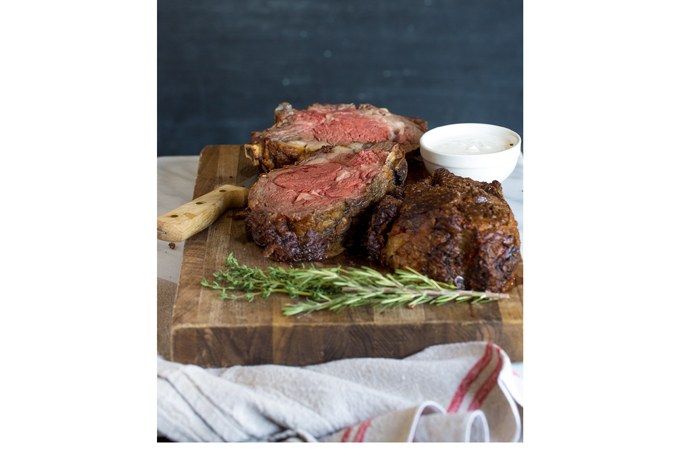How to Make The Perfect Prime Rib
This recipe and photos were provided by Sally Roeckell of Table and Dish and were originally published at 365Barrington.com.
The holidays are here! If you are still in need of a show-stopping main dish for a gathering, a juicy and delicious prime rib is a crowd favorite. So what exactly is a perfect prime rib, anyway?
Whether you buy prime or select, fresh or dry-aged, corn fed or grass-fed, if you don’t cook it right, it won’t be good. Here is my idea of home-cooked prime rib perfection:
- The Perfect Prime Rib must have a deep brown, crisp, crackly, salty crust on its exterior.
- In the Perfect Prime Rib, the gradient from the brown crusty edge to the perfectly medium-rare interior must be absolutely minimized. I don’t want it to be overcooked on the edge and medium-rare only in the middle. I want tender medium-rare throughout.
- The Perfect Prime Rib must retain as many juices as possible. No one likes dry prime rib.

There are opposing schools of thought on cooking Prime Rib. Over the years I have found three reliable methods.
The first is the 22 minutes per pound at 325°f method, also known as the Somewhat Low and Slow method. It does have a fairly consistent medium-rare throughout temperature, but doesn’t obtain that super crispy exterior with bits of flavorful crust. This method requires a good thermometer so at the end you know you have reached the desired temp. If you are using your oven for other things it may change the cooking time as the oven works to heat the added content.
The Sear-It-Last Method method is even lower and slower and gives the perfect edge-to-edge distribution of medium-rare with the crispy crust. This method has you cook the roast at the lowest possible temp 200° until the interior temp of the meat registers 125°. This can take 4-5 hours. At this point take the meat out and let it rest. Once past the initial low-temperature phase of cooking, so long as you kept the roast covered in foil, it will stay warm for over an hour. All you have to do is pop it back into a hot 550°F oven for 8 minutes before your guests are ready to eat, and the roast will emerge hot, sizzling, and ready to carve. There’s no need to rest it after the 550°, since the only part that is being affected is the very exterior.
Finally, there’s the Closed Oven Method. This technique produces a perfectly medium-rare prime rib with a gorgeous brown crust on the outside. There is a little variation of the doneness around the outer edge, but the locked-in juices and butter texture tender meat make that simply ok.
The Closed Oven Method is the method I used and based on today’s results I will ALWAYS do it this way.
This method works best for smaller prime ribs of between 4 and 8 pounds. For a bone-in prime rib, figure two servings per rib, while a boneless roast will yield two servings per pound.
The key to this method is knowing the exact weight of your prime rib to calculate the timing. Also, you don’t actually need a meat thermometer with this technique (although if you’re worried you can certainly use one anyway). I used one when I took the roast out of the oven and it was a perfect 130°.
Over the years I have bought prime ribs from butchers, grocery chains and Costco. This was hands down, the best piece of Prime Rib my family has ever enjoyed. It was perfectly medium-rare and had a buttery, tender texture. It had a crusty, delicious exterior crust and the juices all stayed in the meat. No need for Au Jus.

This is not a cut of meat that you want to choose low-fat since this is where the flavor and juiciness come from. I asked the Heinen’s butcher to cut a piece that was uniform in thickness throughout (for equal cooking). I also asked that he not trim away the fat.
You can see that this piece is well-marbled. On one side there was a pretty large piece of fat inside the roast. Look for meat that is well marbled with consistent-sized lines of fat throughout.
You’ll also notice that there’s no resting time with this recipe, which might come as a surprise if you’re used to resting your meat after roasting it. But with this recipe, it’s not necessary because the meat is basically resting as it sits in the oven.
In years past I have always seasoned my prime rib with cloves of fresh garlic shoved into slits all over the roast. Simply pierce the meat along the fatty top side and slide in a small clove of fresh garlic. I usually add about 8-10 pieces. Then I simply add salt and pepper. Lately, I’ve been using a herb mixture I made to season beef and lamb. It’s a great recipe to use up some extra fresh herbs.
Herb Salt
Ingredients
- 8 fresh sage leaves
- 1/4 cup fresh rosemary leaves
- 2 Tbs fresh thyme leaves
- 1 cup Kosher salt
- 1 Tbs crushed red pepper flakes
- 1 tsp. fennel seeds
- 1/4 tsp. freshly ground pepper
Method
- Pulse the sage, rosemary and thyme in a food processor until coarsely chopped.
- Add salt, red pepper flakes, fennel seeds and black pepper.
- Pulse to blend.
Note: Salt can be made 2 months in advance and kept in an air-tight container at room temperature.
Prime Rib | The Closed Oven Method
Ingredients
- 1 5-6lb bone-in prime rib roast.
- 6-8 Garlic cloves halved (optional)
- Kosher salt and fresh ground pepper
- or 1/4 cup herb salt (recipe above)
Method
- The night before you are going to cook the prime rib, unwrap the roast and season the roast generously with Kosher salt and freshly ground black pepper or herb salt. Let it sit uncovered in the refrigerator.
This will dry out the surface, which makes it easier to get a nice brown color on the roast. Make sure to make note of the exact weight before you throw away the label. - Three hours before you want to begin cooking, take the roast out of the fridge and place it on a sheet pan at room temperature.
- Half an hour before you start roasting, pre-heat your oven to 500°F. Make small slits in the top of the roast to tuck pieces of fresh garlic down into the meat. Add a bit more seasoning.
- Now it’s time to do your calculation. All you do is multiply the weight of your roast by five. That’s your total roasting time, in minutes. For instance, if you have a four-pound roast, 4 × 5 = 20 minutes. An eight-pound roast? 8 × 5 = 40 minutes.
- When you’re ready to cook, set the roast in a roasting pan with a rack, fat-side-up. If you’re nervous about this technique, you can insert a meat thermometer or a digital probe thermometer into the deepest part of the meat, being careful not to hit bone.
- Now put the roast in the oven and roast it for exactly, however, many minutes you calculated above. When the time’s up, turn off the oven and walk away.
- Don’t open the oven door for any reason for the next two hours. Tell anyone in the house the rules so they don’t unknowingly take a peek to see where the great smells are coming from.
- In two hours, take the prime rib out of the oven, carve and serve right away. If you did use a thermometer, you’ll see that the internal temperature of the meat has reached 130°F — in other words, perfect medium-rare.
Note: Instead of Au Jus which is not needed with this incredibly juicy piece of meat I like to serve it with a creamy horseradish sauce. Simply stir about two Tbs of horseradish into 1 cup of sour cream.




